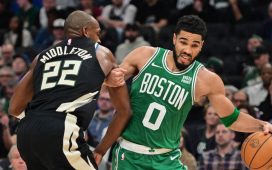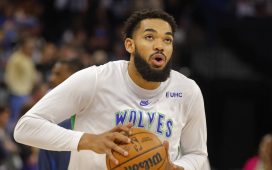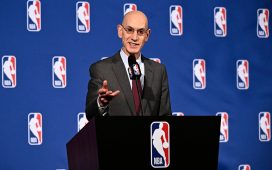There will be a serious and spirited debate over the next month about what order Gonzaga’s Chet Holmgren, Duke’s Paolo Banchero and Auburn’s Jabari Smith should be picked in the 2022 NBA Draft. Each has a strong case to go No. 1, and none is likely to fall outside the top three with Orlando, then Oklahoma City, then Houston getting the honor of selecting one of the center-sized stars with guard skills. So how do those three stack up against each other?
Few are as qualified to answer that question as Arkansas coach Eric Musselman, the former Timberwolves, Magic, Hawks and Grizzlies assistant and Warriors and Kings head coach, whose team faced each of those elite prospects in the span of a month this season. Smith had 20 points and nine rebounds and hit 6 of 16 shots in a loss to the Razorbacks. Holmgren had 11 points and 14 boards and fouled out in 23 minutes during a Sweet 16 loss to Arkansas. Banchero went for 16 points, seven boards and three assists in an Elite Eight win over the Hogs.
“I could see a reason to pick all three of them,” Musselman told The Athletic this week. “They’re all legitimate top-three picks. If you’re drafting that high and there’s not much separation, trade the pick. But these guys are all worthy. The amazing thing to me about all three of them is what they can do at their size and age. These are freshmen. We aren’t talking about somebody in their fourth or fifth year who is maxed out. So now it’s what is their work ethic and what kind of organization do they end up with? That’ll determine how these three careers unfold. But they each have the tools you’re looking for at the top of the draft. In the NBA, it’s simple: What super skill do you have that sets you apart from others? If you don’t have one, then you’re just a rotation guy.”
Holmgren’s super skill is “shot blocking and length,” Musselman said. Smith’s is “being 6-foot-10 and an elite shot-maker.” Banchero’s is “being 6-10 and excelling in all three phases: off the bounce, mid-post and at the rim.” Bottom line: They all do something so exceptionally that Musselman is confident they will succeed as pros.
In 2017, after his Nevada team faced Markelle Fultz at Washington (and won), he was not at all convinced he’d just seen the eventual No. 1 pick. In fact, he was “absolutely shocked” when it went down that way on draft night.
“Having coached in the NBA, I didn’t even think he was a first-round pick, let alone the No. 1 pick,” Musselman said. “But the most interesting thing about this process is how much research the winning teams that draft so well truly do, and on the flip side how little some others do. The only teams who called me about Fultz were the winning teams. Anyone who asked, I could’ve told them that was a mistake. If you cannot help your college team win, there should be a concern — unless it’s a guy like Anthony Edwards, who had no pieces around him but just stood out so much physically — and that’s what I love about these three guys this year. They won at a high, high, high level.”
Unlike Fultz, and despite Georgia’s struggles in 2020, Musselman had zero doubt that the Timberwolves made the right call taking Edwards No. 1 that year.
“I watched the layup line when we played Georgia and could tell you, ‘This guy is a bona fide starter right out of the gate,’” Musselman said. “That night, we had no answer for Edwards. He was bionic. He was superhuman. The lift on his jump shot, he was getting off the ground like three feet higher than our guys, it felt like, and we couldn’t even contest his shot. We could not bother him. His strength and his athleticism, it was just different than everybody else. That’s what you’re looking for at No. 1. And you can argue all three of the guys this year have it.”
But one of them has to come off the board first. So in what order would Musselman go after scouting, game-planning and facing each of them? It’s Banchero, Smith, then Holmgren for him.
“If I was in a draft room, that would be my feeling, but every team has got different needs and timelines,” he said. “Somebody might want to draft Chet because they have more of a long-term plan. Somebody might need perimeter shooting and a guy who can space the floor, and Jabari would be that guy. But just playing against the three, Paolo was the hardest for us to deal with.”
Which brings us to the scouting reports. Here’s how Musselman views the Big Three, in his order:
1. Paolo Banchero, Duke
On offense: “He was the one we just had no answer for. Our scouting report couldn’t take anything away from him. When they needed a basket, it went to him. He got the ball off where we couldn’t double-team or soft-trap him. He makes 3s and just kept improving as a 3-point shooter over the year. He knows how to draw fouls. He’s excellent in the midrange. He’s got a good jab-step, pull-up jump shot. Got a really good turnaround jump shot. Can run the floor. Actually, you know what? I think he might be even more athletic than Jabari. It’s probably about even.”
On defense: “We couldn’t get a mismatch because they had so many equal-sized guys and then they went zone, so I did not get a good feel for him as a defender. But we didn’t go at him a lot. We didn’t feel like we had an advantage to post him up at all and didn’t feel like we had an advantage off the bounce to try to go at him or get him in foul trouble. So we really just kind of stayed away from him.”

Jabari Smith scored 20 points in a loss at Arkansas. (Nelson Chenault / USA Today)
2. Jabari Smith, Auburn
On offense: “He’s so unique with his ability to make shots from so deep and doesn’t need a lot of dribbles to get them off. He can shoot over people. There’s just not a lot of guys his age or size who can shoot transition 3s off the run and catch like he can. It’s a little bit like Klay Thompson, who doesn’t dribble a lot and can be in a dead sprint, catch, plant and stick it. Jabari does that really well, which is a remarkable thing at 6-10. Our plan was just to crowd him, not let him go left at all. We felt like if he got the left-hand, 1-2 dribble, he was virtually unstoppable. He’s really unique, because you don’t often see a right-handed player love to put the ball on the deck with his left hand. We went through all his makes and felt like he was probably the most unique right-hand guy we’ve ever seen.”
On defense: “He’s so long, the only thing we tried to do is maybe get a switch where a smaller guy could try to attack off the bounce. Even then, you might have a lateral-quickness advantage with a smaller guy, but Jabari’s reach makes it really hard. I thought he was great at slapping and jabbing at the ball.”

Chet Holmgren was bothered by Arkansas’ physicality in Gonzaga’s Sweet 16 upset loss. (Kelley L Cox / USA Today)
3. Chet Holmgren, Gonzaga
On offense: “Tremendous upside with his length, shooting and passing. He’s really intriguing. For us, the game plan was to get up under him out on the perimeter, get as low as we possibly could and try to swallow up any dribbles that he might take. And then in the post, it was to use our low center of gravity and try to be as physical as possible. Any time he sets screens, just be as physical as we could and try to impede his path anywhere that he was on the floor. We wanted our strongest, most physical player on him.”
Arkansas assigned 6-foot-6, 225-pound Trey Wade, a journeyman who averaged six points per game at three schools and then got an NFL mini-camp tryout as a tight end, to guard the slender, 7-foot, 195-pound Holmgren. This highlights one major concern about Holmgren at the next level: whether he can hold up physically.
On defense: “We said no floaters when we went to the basket. Try to get him in rotations and attack his body physically on our dribble drives. We didn’t want to settle and take midrange shots against him. If he came over from the weak side, our goal was to score inside the restricted area, basically, and to go through his body and try to draw fouls. (Holmgren fouled out for just the third time all season.) No soft layups. It was a relentless attack at the rim if you saw him come from the weak side. We knew he would block a couple shots, but we wanted to be aggressive getting into his body on our last dribble into the shot. Right now, that’s going to be the way you go after him — but there’s just not many guys his size and age who can dribble, pass and shoot as well as he can. Plus, he’s a great shot-blocker with good ability and mobility at that size. There’s a lot to like about that kid, too.”
(Top photo of Paolo Banchero: Lance King / Getty Images)





